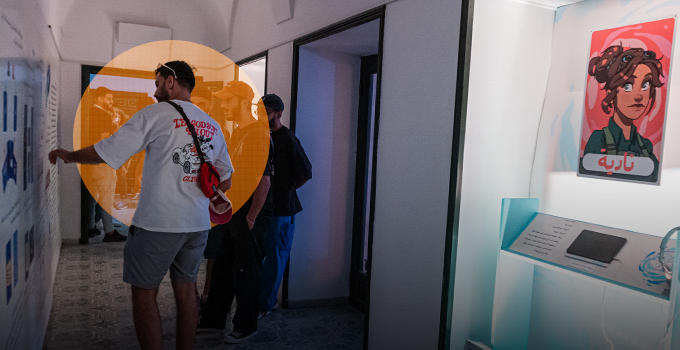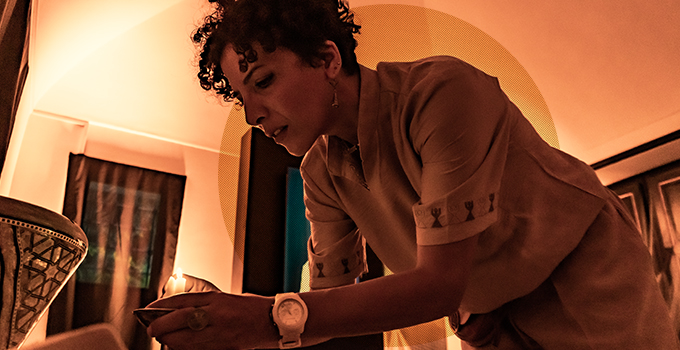
Late in the afternoon on Sunday, November 8, not a few yellow wrist-banded, map-toting individuals circulated the winding streets of the Medina to catch the last hours of Dream City. Animating one of the dimmer passageways of the old city, a line of thirty or so people—laughing, chatting, smoking—awaited entry into the Caserne el Attarine which had been converted, for five short days, into the National Museum of the State Security System.

In staggered groups of three or four, visitors filtered inside the building. In a foyer illuminated by fluorescent lights, a security guard waved a metal detector over bodies and belongings; backpacks and purses were stashed away in numbered cubbies, and visitors were handed a museum map before crossing an empty grey courtyard into the exhibit.

Beside the voices of docents and murmurs of overlapping tour groups that drifted through rooms and hallways, a mix of cold and silence were heavy in the air. The walls were bare except for cracks and chips in the white paint. Two archive rooms in disarray contained files and papers which (by some trick of artistry or imagination) appeared to have been untouched and collecting dust for years.

Beyond Memory Hall, where a pale yellow table bore, in blood red calligraphic letters, an ode “to all political prisoners alive and dead,” was a narrow hallway. There, four nearly identical Investigation Rooms were sparsely furnished with, in the same configuration, iron desk, telephone, chair, file cabinet.

The repeated austerity of the rooms evoked the mechanized interrogation which might have been carried out there, the frequent and hasty passage of people like Najwa Rezgui.

Najwa Rezgui and Ilyes Lafi were political prisoners under the former regime. They were also the tour guides for Soliman and Gielens’ National Museum of the State Security System, not only leading tour groups from room to room but sharing their own experiences along the way. The following is a translated excerpt from Rezgui’s testimonial which was featured in the exhibition:
His name was Abdelmajid, that was all I knew about him. They had brought me to a white car without the National Guard plate. They made me get in the back and seated me between two agents who locked the doors behind them. The car took off in the direction of Kairouan, ten kilometers from the University.
“As is their habit, they took me—in the humiliating way that they take an animal to the slaughterhouse—to the district of the National Guard where the political police were waiting. The expressions of these agents foretold of no good. One of them grabbed a wooden baton and began to hit me across my entire body. He was yelling as he hit me, and I could only catch a few words which have become etched into my memory because he kept repeating hysterically, “I swear I’ll make an informant of you, bitch.” Another intervened and pushed me towards a room where I found some of my peers as well as a large number of students only some of whom I knew. They were all seated on the floor, heads turned facing the wall. They struck me as I was forced to join them…

Organizing reality and fiction
It was a fictional museum, Laila Soliman emphasizes, reminding us what was so easy to forget after exploring the rooms and hallways of the transformed Caserne el Atterine. Indeed, the National Museum of the State Security System is one of several artistic works that Egyptian playwright-director Laila Soliman and Belgian actor-director Ruud Gielens have created together. The artists were approached by Selma and Sofiane Ouissi of L’Art Rue and curator Jan Goossens to create a project for the most recent edition of Dream City. Soliman shared some time with Nawaat to talk about the creative process behind their creation, a glimpse into the unofficial narrative of the state security apparatus that operated under the Ben Ali regime.
Although the Museum itself was fictional (in the sense that it was not actually initiated by the State), the stories and sentiments housed and evoked within its walls were not. In keeping with the theme of Dream City creations, Soliman explains, the project was inspired and informed by “different calibers of citizens” in Tunis. Based on the stories, experiences, memories, of citizens—Soliman and Gielens interviewed thirty individuals—and the physical spaces explored in the Medina, the artists decided on the spatial and visual format of the Museum.
Asked about what appeared to have been an extensive research process (and since archives and historical documents have played a vital role in Soliman’s previous works), Soliman points out that research takes different forms, and that in this case, interviews were the fundamental source of information. Every word said, real or imaginary, says Soliman, fleshed out the space. While the Projection Room was the only completely nonfictional part of the exposition, “the details of every corner” of the Museum could be traced back to the interviews. That these testimonials were featured in the last room before the exit was a choice which reflected “the organization of reality and fiction.”
Not a permanent model, but a collective moment
The preservation of national memory is a right guaranteed to all successive generations of Tunisians, and an obligation of the State and all affiliated institutions, and this to the end of learning from lessons and commemorating victims. Article 5, Law n°2013-53 of 24 December 2013
On 24 December 2013, Tunisia’s transitional justice law established the Truth and Dignity Commission and promoted the revelation of truth as well as the preservation of national memory. As the country undertakes its own transitional justice process, one cannot help but wonder about the potential for Soliman and Gielen’s project to serve as a model for an actual memorial. But Soliman is clear that such was neither the intention for nor the context in which to consider the Museum.

The playwright’s previous works—theatre performances which evoke the relevance of the past to understand the present, which use art as a tool to spread information—offer some insight. In theater, the audience responds to the performance of actors on stage; in the Museum, the audience took a journey through and responded to a space. Both contexts create a powerful and fleeting experience that is shared by spectator and artist. In this sense, Soliman describes the Museum as the creation of a “collective moment … a moment of sharing knowledge, a moment of opening up something” that is sensitive and not readily accessible or examined in the public sphere.
All photographs and testimonial documents courtesy of Ruud Gielens.
Dream City 2015: the social connection
07/11/2015






iThere are no comments
Add yours